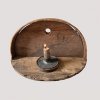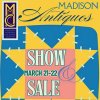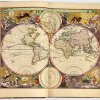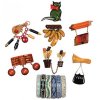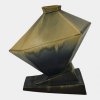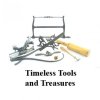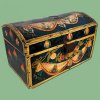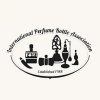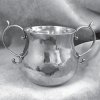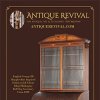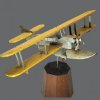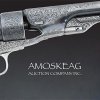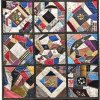Alderfer's Catalog Sale
October 3rd, 2017
Alderfer Auction Co., Hatfield, Pennsylvania
Photos courtesy Alderfer Auction Co.
Sherry Russell, who bought Alderfer Auction Co. last January, sees her job as helping people through life’s transitions. “Our job at Alderfer’s is finding solutions. We are in the business of selling for people downsizing, settling estates, redecorating, or just wanting to sell,” she said. Alderfer sells art, antiques, jewelry, toys and dolls, firearms and militaria, cars, tools, books and manuscripts, collectibles, and household goods.
“For our catalog sales, we save special items from all our estate sales,” said Brent Souder, director of sales and chief auctioneer. “Sometimes just one or two items from a consignment are pulled and sometimes entire collections.” Alderfer holds catalog sales three or four times a year.
Alderfer still holds old-fashioned biweekly live public auctions on Thursdays selling consignments from estates. Sometimes they are specialized sales of toys and dolls, decoys, guns and militaria, coins, stamps, or vintage clothing. For example, on Tuesday, October 3, an online-only toy auction was followed on October 4 by a live and online doll auction of 500 lots listed and pictured in a spiral-bound catalog. A printed catalog is $20, and an online catalog is free.
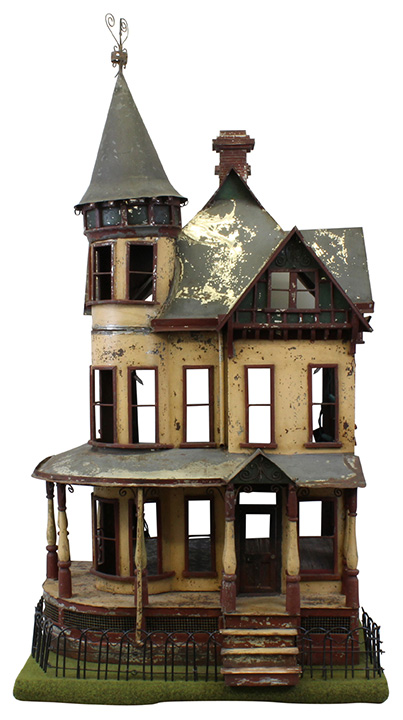
This circa 1900 painted tin dollhouse, built by Oscar DeLong of Reading, Pennsylvania, shows DeLong’s fine craftsmanship as a welder and was possibly a gift to his daughter Ada Mae, born in 1890. It is 36½" x 18" x 22½" and sold on the phone for $3600 (est. $1000/2000).
On Thursday, September 28, the biweekly live auction was a discovery sale of prints and paintings that started at 9 a.m. and was still going on when the catalog sale began at noon. At some biweekly Thursday sales there can be as many as three auctions going on simultaneously—china and glassware in one part of the room and jewelry in another, and furniture in the hallway. These sales can be previewed the Tuesday and Wednesday before the sale.
In order to accommodate millennials, who tend not to attend live auctions, Alderfer’s has been offering many more online-only auctions. Some are for a single estate or household, others for a single category. Sometimes the items for sale are available for inspection at Alderfer’s spacious salesroom in Hatfield during advertised preview times. Sometimes the items are not moved out of the house. These items can be previewed in the house at notified times and can be picked up at the house or for a fee picked up at Alderfer’s. Everything is photographed, and the pictures are posted online, along with descriptions, five or ten days before the close of the auction. During the sale, online bidders are notified if they have been outbid and can raise their bids. If a bid is executed within three minutes of the lot’s scheduled end time, the time is extended for three minutes from the last bid. Extending bidding continues until two hours after the last lot’s scheduled time to sell. All bids are billed to the highest bidder’s credit card at the time of purchase, and the buyer’s premium is added.
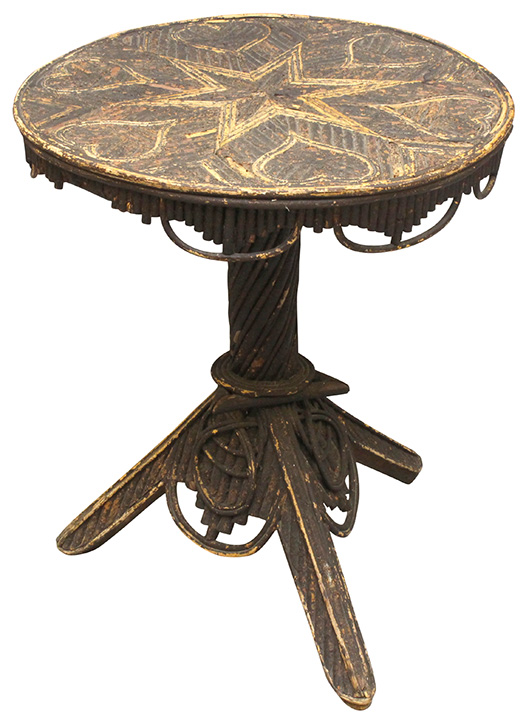
This Adirondack center table with a star and heart in its wicker top and a twisted pedestal on a tripod base, 26" high x 22½" diameter, sold online $2250 (est. $600/900).
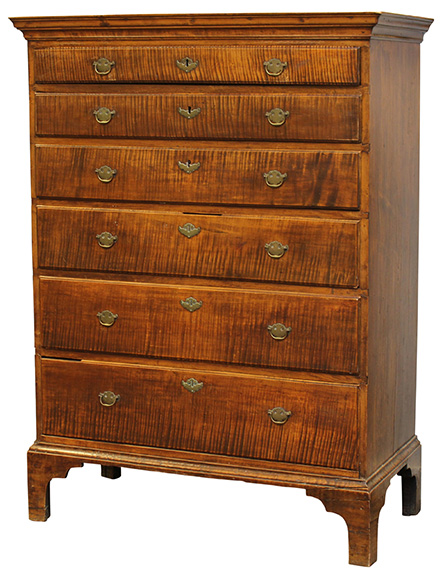
Tiger maple chest of drawers with a molded top and six graduated drawers, 53" x 39" x 20", sold on the phone for $3000 (est. $600/900).
Russell said 376 people signed up to bid either in person or on the phone at the September 28 catalog sale. Nevertheless, 50% of the lots went online, 11% to Invaluable and 39% to LiveAuctioneers. While 85% of the bidders in the biweekly sales are dealers, a larger number of private collectors in the salesroom were active bidders at the catalog sale.
 Two quilt dealers in the salesroom competed with each other and with collectors in the salesroom and with phone bidders for a special collection of quilts on September 28. The quilts had been presented in a 1991 catalog by Victoria Hoffman, a Brooklyn, New York, collector and dealer who had participated in quilt festivals in Japan in the late 1980s and met Sanki Nohara, president of the Hearts and Hands Patchwork School in Tokyo, who asked Hoffman to introduce American quilting traditions to his students. Hoffman put together an exhibition of quilts, accompanied by a catalog, emphasizing their historical context. The exhibit, first shown in Japan in 1990-91, traveled to the Museum of American Textile History in North Andover, Massachusetts, with the accompanying catalog in English. Auctioneer Brent Souder announced from the podium that each buyer of a quilt from the collection would also receive a catalog.
Two quilt dealers in the salesroom competed with each other and with collectors in the salesroom and with phone bidders for a special collection of quilts on September 28. The quilts had been presented in a 1991 catalog by Victoria Hoffman, a Brooklyn, New York, collector and dealer who had participated in quilt festivals in Japan in the late 1980s and met Sanki Nohara, president of the Hearts and Hands Patchwork School in Tokyo, who asked Hoffman to introduce American quilting traditions to his students. Hoffman put together an exhibition of quilts, accompanied by a catalog, emphasizing their historical context. The exhibit, first shown in Japan in 1990-91, traveled to the Museum of American Textile History in North Andover, Massachusetts, with the accompanying catalog in English. Auctioneer Brent Souder announced from the podium that each buyer of a quilt from the collection would also receive a catalog.
The quilts were the stars of the Americana section of the sale, with most selling well over estimates, although two Victorian crazy quilts sold well under their $300/500 estimates at $210 (including buyer’s premium) and $270. A stunning blue, red, and gray Triple Irish Chain Mennonite quilt from Berks County, Pennsylvania, sold on the phone for $900, and an Amish quilt in green, orange, and gray with a red diamond went to the phone for the same price, more than double their high estimates. An appliquéd Whig Rose quilt sold for $1170, a Star of Bethlehem quilt, $1872, and a Rocky Glen large quilt sold for the same price, $1872. A Mariner’s Compass quilt sold for $2040, three times its conservative estimate. These results suggest that quilt prices are somewhat stronger and that early quilts are in demand, while quilts from the 1920s and 1930s are quite affordable.
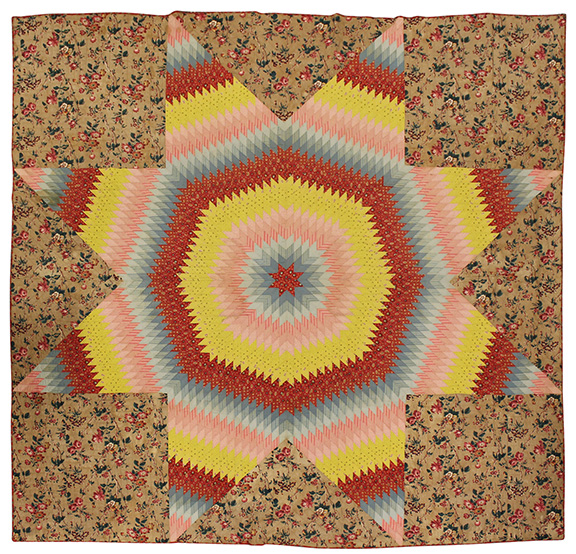
This pieced Star of Bethlehem quilt, circa 1840, is a very large (123½" x 118½") Pennsylvania cotton chintz plain weave, roller-printed quilt. It sold to a dealer in the salesroom for $1872 (est. $300/500), underbid on the phone.
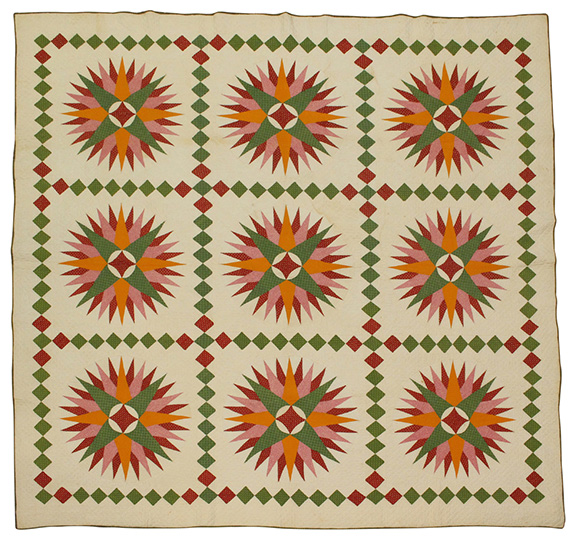
This 79" x 82" Mariner’s Compass pieced quilt, 1870s, cotton, plain weave, with a hand-sewn sleeve for hanging, found in Pennsylvania, sold on the phone for $2040 (est. $400/600).
The sale began with historical documents and autographs and Civil War cartes de visite and tintypes, followed by a variety of jewelry, silver, and bric-a-brac, a few Oriental rugs and carpets, and a small selection of furniture, including seven tall-case clocks, and ended with 136 lots of prints and paintings.
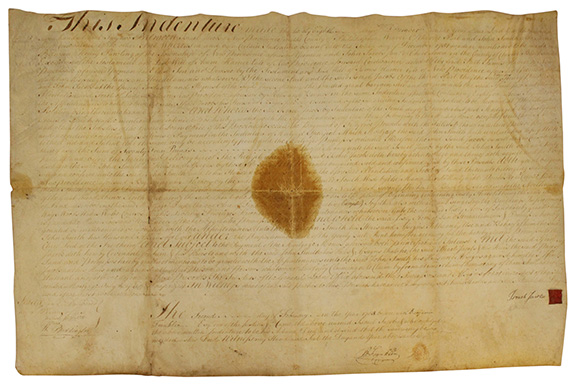
Pennsylvania indenture, dated December 28, 1762, for 60 acres of land in New Providence, Philadelphia County, signed by Benjamin Franklin as justice on February 2, 1763. The 17" x 25" vellum document has folds and a stain measuring 4½" x 3", and there is some fading to the text, though the signature is strong. The document sold for $8750 (est. $3000/5000).
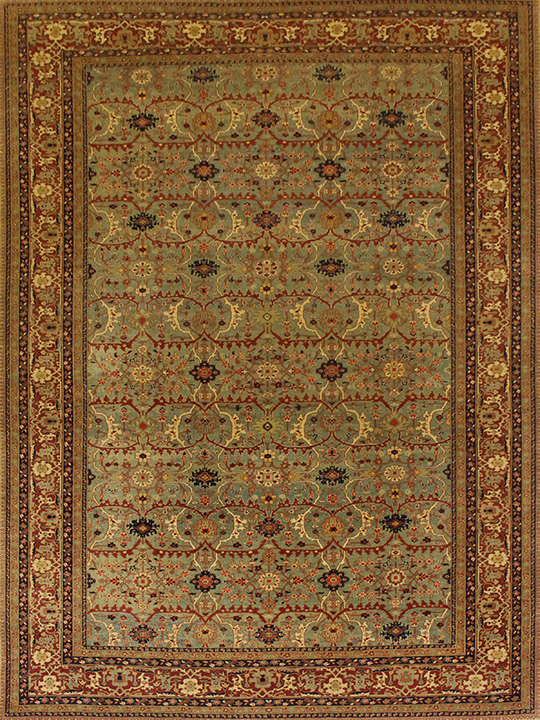
A room-size (11'8" x 17'11") Turkish carpet with a floral and vine pattern on an ivory field with some red in the border sold for $3802.50 in the salesroom. It was the most expensive of seven rugs in the sale.
People came and went all afternoon, but there always seemed to be at least 60 people in the salesroom competing with the very active online bidders. The sale was 99% sold; only three lots were passed of the 443 offered. The sale brought a total of $501,146, which was toward the top of estimates ($231,000/530,000, figured without buyers’ premiums).
The most competitive bidding was for a still life oil on canvas of daisies by Irma Stern that sold for $45,000 to an online bidder after two phone bidders had competed up to $36,000. Irma Stern (1894-1966) was a well-traveled South African artist; her house in Cape Town is now a museum. Several of her paintings of African subjects have sold for millions at Bonhams in London.
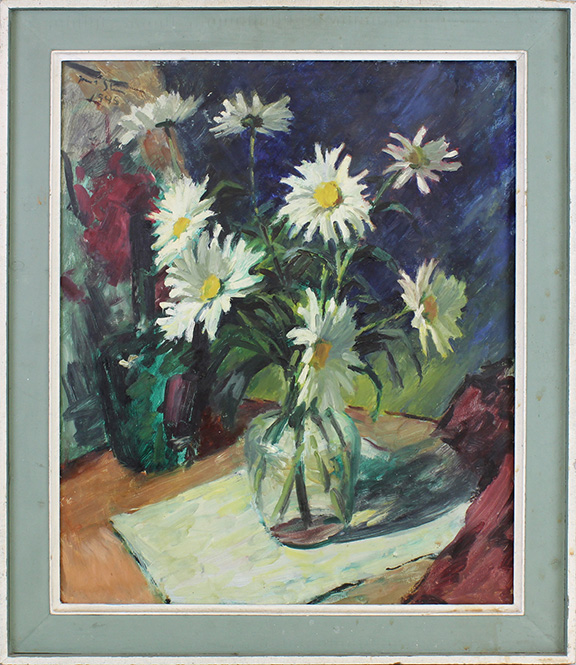
A vase of daisies by Irma Stern (South African, 1894-1966), a 24" x 20" oil on board, signed and dated 1945, sold for $45,000 (est. $20,000/30,000) online, underbid by telephone bidders. Stern’s work is avidly collected in South Africa. Her house in Cape Town is open as a museum. In 2015 Bonhams in London sold Irma Stern’s Arab in Black, painted in 1939, for $1,111,969 (£842,500). In the late 1950s, it had been part of a charity auction to help fund Nelson Mandela’s legal defense. Bonhams found that painting in a London flat being used as a message board. The record price paid for an Irma Stern painting is $3,985,605 (£3,044,000) paid for Arab Priest when it sold at Bonhams in March 2011. At the same sale Seated Nude with Oranges brought $2,243,737 (£1,700,000). In September 2017 Bonhams sold Zanzibar Street Scene for $65,992 (£50,000).
Stern was born in South Africa to German Jewish parents. After the Boer War, the family returned to Germany, where she studied art and was associated with German Expressionist painters. She held her first exhibition in Berlin in 1919 and in 1920 returned to Cape Town with her family. By 1940 Stern was an established artist. She traveled extensively in Europe and explored Africa. She published journals of her travels. She exhibited in South Africa and Europe during her lifetime. The Irma Stern Museum was established in 1971 in the house where she lived from 1921 until she died in 1966. The upstairs galleries are used to exhibit work by contemporary South African artists.

This clock by Jacob Hage of Lower Salford, Bucks County, with a painted dial, moon phase, and eight-day works, in a 93" high cherry case with a scrolled broken-arch pediment and columns, arched door, reeded corner columns, and ogee feet, sold in the salesroom to a Bucks County collector for $5557.50 (est. $3000/5000).
A pair of early 19th-century English terrestrial globes sold for $6250 (est. $6000/9000); they probably sold for a lot more at Christie’s in 2001. The furniture was disappointing. A clock by Jacob Hage of Lower Salford, Pennsylvania, in a 93" tall cherry case went to a collector in the salesroom for $5557.50, which was more than the $4687.50 paid for a Steinway baby grand piano. A Ty Cobb tobacco card showing the outfielder with his bat brought $1625, and another card showing Ty Cobb with his glove went for $687.50, the same price as two of Harry Houdini’s slightly rusty iron escape tools. The consignor of an Adirondack wicker table must have been surprised to see it double its high estimate and sell for $2250 (est. $600/900).
For more information, see the website (www.alderferauction.com) or call (215) 393-3000.
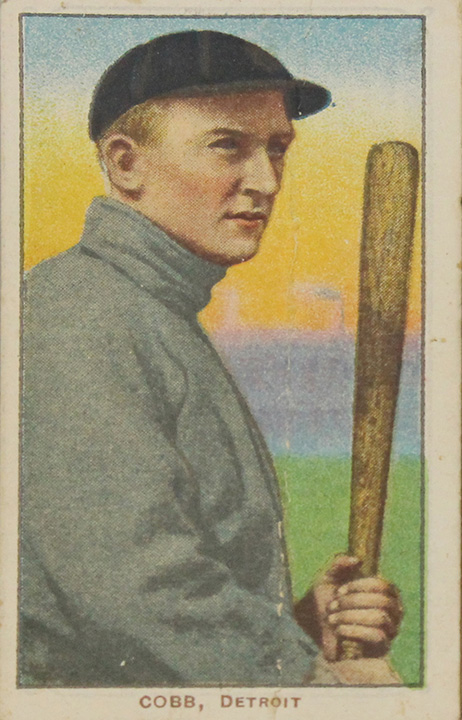
This baseball card from the T206 series features Ty Cobb with the bat off his shoulder. The card exhibits some wear, with slight rounding to corners and a light vertical crease. The reverse features an ad for Polar Bear scrap tobacco. The card sold for $1625 (est. $300/500).
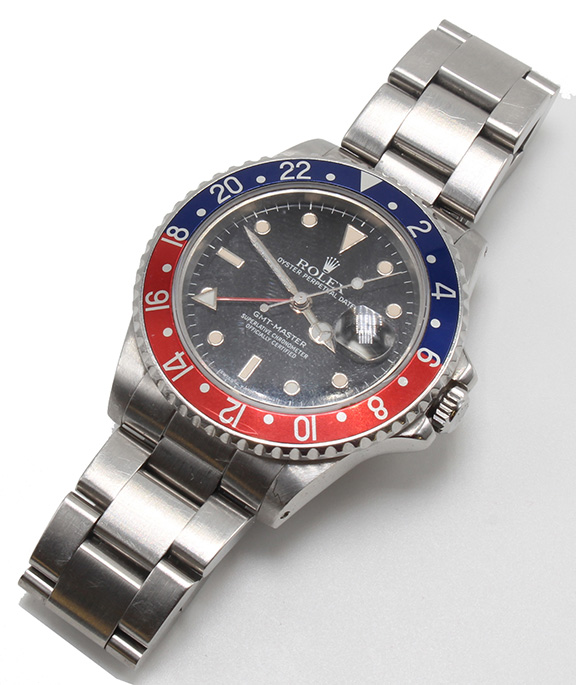
This 1988 Rolex GMT-Master, 8¼" long, with a perpetual date, stainless steel with a black dial with blue-red bezel, is serial #R714016. It sold with its original box, authenticity certificate, serial card, operation manual, and felt pouches for $6875 online, even though auctioneer Brent Souder announced from the podium that it needed about $1000 worth of repairs.
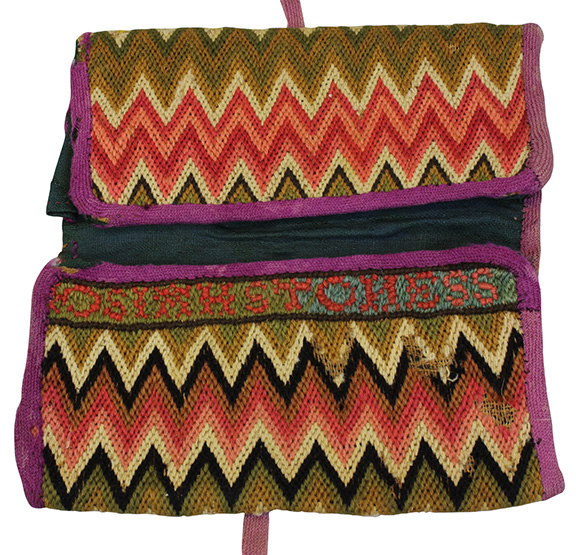
This flame-stitch woven cloth gentleman’s pocketbook has a purple binding. Accompanying documentation states, “This Pocketbook was made by Sarah Stone Croosman in 1759 for her twin brother Josiah Stone (my Grandfather) when she was 9 years old. It is 140 years old to this date 1899. M. A. Morgan.” Folded, it measures 8" x 4½". It sold in the salesroom for $875 (est. $300/500).
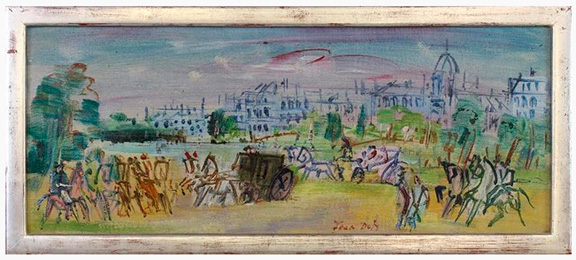
An 8½" x 20¾" oil on canvas by Jean Dufy (French, 1888-1964) with an Arthur Lenars & Cie., Paris, label sold for $15,000 (est. $8000/12,000).
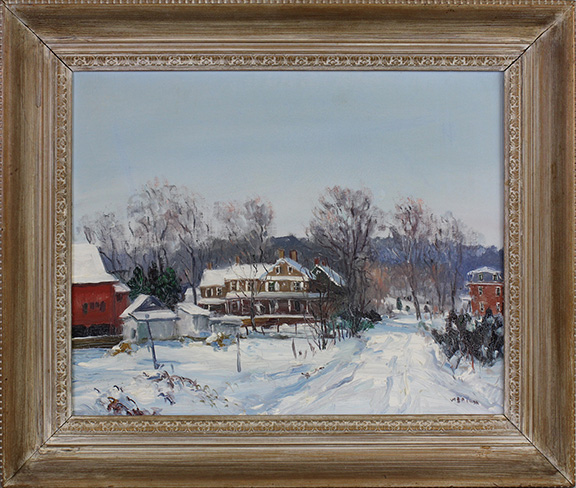
There were several paintings by Walter Emerson Baum (1884-1956). This one, Winter,16" x 20", sold for $6875 (est. $1500/2500). Not shown: one the same size, A Red House in Winter, sold for $4687.50 (est. $2000/2500); another, slightly larger, titled on the back A Church on the Hill, sold for $5312.50 (est. $2000/2500). It is a fall scene without snow. Another Baum, 8" x 10", Blue Mountain, Lehigh County,sold for $4062.50 (est. $2000/3000). There is a solid market for framed, ready-to-hang Bucks County landscapes by the most prolific of the Bucks County Impressionist painters.
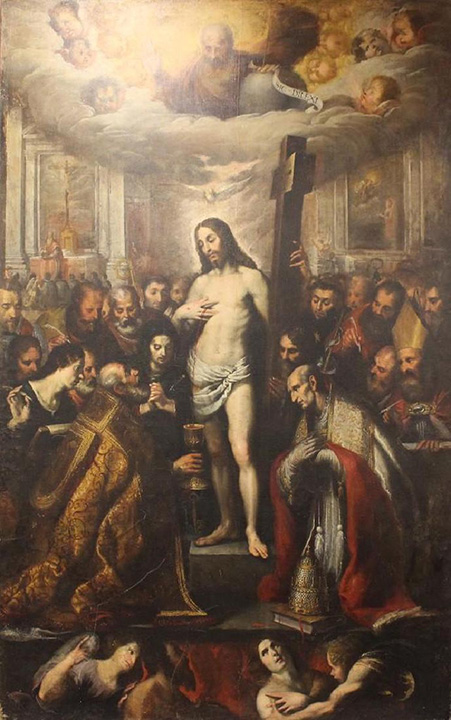
Attributed to Clemente Bocciardo, also called Il Clementone (Italian, 1620-1658), Corpus Domini, an oil on canvas signed “MENS ARDVS” and dated illegibly lower left, 121" x 76" unframed, sold for $18,750 (est. $1000/2000).
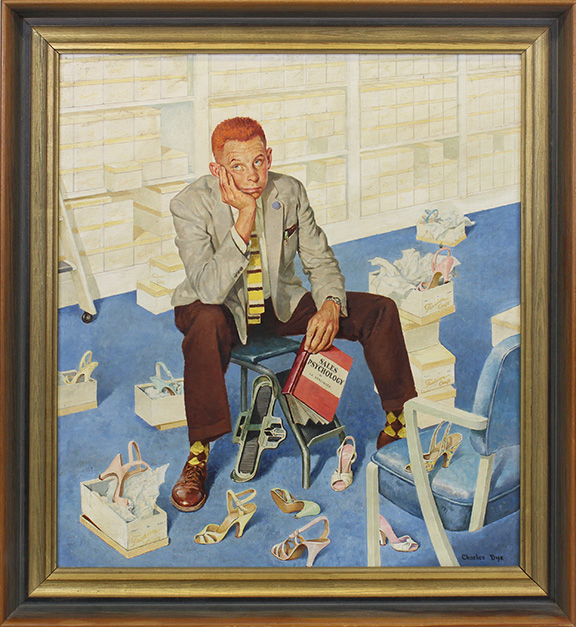
Salesman by Charles Dye (1906-1973), an illustration on board, 22" x 19½", sold for $13,750 (est. $3000/5000), showing the strength of the market for illustration.
Originally published in the December 2017 issue of Maine Antique Digest. © 2017 Maine Antique Digest
